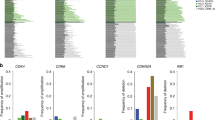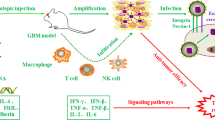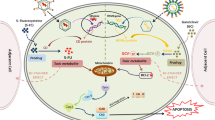Abstract
Malignant gliomas are the most frequently occurring primary brain tumors and are resistant to conventional therapy. Conditionally replicating adenoviruses are a novel strategy in glioma treatment. Clinical trials using E1B mutant adenoviruses have been reported recently and E1A mutant replication-competent adenoviruses are in advanced preclinical testing. Here we constructed a novel replication-selective adenovirus (CB1) incorporating a double deletion of a 24 bp Rb-binding region in the E1a gene, and a 903 bp deleted region in the E1b gene that abrogates the expression of a p53-binding E1B-55 kDa protein. CB1 exerted a potent anticancer effect in vitro in U-251 MG, U-373 MG, and D-54 MG human glioma cell lines, as assessed by qualitative and quantitative viability assays. Replication analyses demonstrated that CB1 replicates in vitro in human glioma cells. Importantly, CB1 acquired a highly attenuated replicative phenotype in both serum-starved and proliferating normal human astrocytes. In vivo experiments using intracranially implanted D-54 MG glioma xenografts in nude mice showed that a single dose of CB1 (1.5 × 108 PFU/tumor) significantly improved survival. Immunohistochemical analyses of expressed adenoviral proteins confirmed adenoviral replication within the tumors. The CB1 oncolytic adenovirus induces a potent antiglioma effect and could ultimately demonstrate clinical relevance and therapeutic utility.
This is a preview of subscription content, access via your institution
Access options
Subscribe to this journal
Receive 50 print issues and online access
$259.00 per year
only $5.18 per issue
Buy this article
- Purchase on Springer Link
- Instant access to full article PDF
Prices may be subject to local taxes which are calculated during checkout






Similar content being viewed by others
References
Alemany R, Balague C and Curiel DT . (2000). Nat. Biotechnol., 18, 723–727.
Babiss LE, Ginsberg HS and Darnell Jr JE . (1985). Mol. Cell. Biol., 5, 2552–2558.
Balague C, Noya F, Alemany R, Chow LT and Curiel DT . (2001). J. Virol., 75, 7602–7611.
Bauerschmitz GJ, Lam JT, Kanerva A, Suzuki K, Nettelbeck DM, Dmitriev I, Krasnykh V, Mikheeva GV, Barnes MN, Alvarez RD, Dall P, Alemany R, Curiel DT and Hemminki A . (2002). Cancer Res., 62, 1266–1270.
Bischoff JR, Kirn DH, Williams A, Heise C, Horn S, Muna M, Ng L, Nye JA, Sampson-Johannes A, Fattaey A and McCormick F . (1996). Science, 274, 373–376.
Cripe TP, Dunphy EJ, Holub AD, Saini A, Vasi NH, Mahller YY, Collins MH, Snyder JD, Krasnykh V, Curiel DT, Wickham TJ, DeGregori J, Bergelson JM and Currier MA . (2001). Cancer Res., 61, 2953–2960.
Fueyo J, Alemany R, Gomez-Manzano C, Fuller GN, Khan A, Conrad CA, Liu TJ, Jiang H, Lemoine MG, Suzuki K, Sawaya R, Curiel DT, Yung WK and Lang FF . (2003). J. Natl. Cancer Inst., 95, 652–660.
Fueyo J, Gomez-Manzano C, Alemany R, Lee PS, McDonnell TJ, Mitlianga P, Shi YX, Levin VA, Yung WK and Kyritsis AP . (2000). Oncogene, 19, 2–12.
Heise C, Hermiston T, Johnson L, Brooks G, Sampson-Johannes A, Williams A, Hawkins L and Kirn D . (2000). Nat. Med., 6, 1134–1139.
Howe JA, Demers GW, Johnson DE, Neugebauer SE, Perry ST, Vaillancourt MT and Faha B . (2000). Mol. Ther., 2, 485–495.
Jakubczak JL, Ryan P, Gorziglia M, Clarke L, Hawkins LK, Hay C, Huang Y, Kaloss M, Marinov A, Phipps S, Pinkstaff A, Shirley P, Skripchenko Y, Stewart D, Forry-Schaudies S and Hallenbeck PL . (2003). Cancer Res., 63, 1490–1499.
Johnson L, Shen A, Boyle L, Kunich J, Pandey K, Lemmon M, Hermiston T, Giedlin M, McCormick F and Fattaey A . (2002). Cancer Cell, 1, 325–337.
Jones N and Shenk T . (1979). Cell, 17, 683–689.
Lal S, Lacroix M, Tofilon P, Fuller GN, Sawaya R and Lang FF . (2000). J. Neurosurg., 92, 326–333.
Lamfers ML, Grill J, Dirven CM, Van Beusechem VW, Geoerger B, Van Den Berg J, Alemany R, Fueyo J, Curiel DT, Vassal G, Pinedo HM, Vandertop WP and Gerritsen WR . (2002). Cancer Res., 62, 5736–5742.
Levine AJ . (1990). Bioessays, 12, 60–66.
Lillie JW, Loewenstein PM, Green MR and Green M . (1987). Cell, 50, 1091–1100.
Maher EA, Furnari FB, Bachoo RM, Rowitch DH, Louis DN, Cavenee WK and DePinho RA . (2001). Genes Dev., 15, 1311–1333.
Pilder S, Moore M, Logan J and Shenk T . (1986). Mol. Cell. Biol., 6, 470–476.
Ramachandra M, Rahman A, Zou A, Vaillancourt M, Howe JA, Antelman D, Sugarman B, Demers GW, Engler H, Johnson D and Shabram P . (2001). Nat. Biotechnol., 19, 1035–1041.
Shenk T and Flint J . (1991). Adv. Cancer Res., 57, 47–85.
Suzuki K, Fueyo J, Krasnykh V, Reynolds PN, Curiel DT and Alemany R . (2001). Clin. Cancer Res., 7, 120–126.
Tsukuda K, Wiewrodt R, Molnar-Kimber K, Jovanovic VP and Amin KM . (2002). Cancer Res., 62, 3438–3447.
van Beusechem VW, van den Doel PB, Grill J, Pinedo HM and Gerritsen WR . (2002). Cancer Res., 62, 6165–6171.
Whyte P, Ruley H and Harlow E . (1988). J. Virol., 62, 257–261.
Whyte P, Williamson N and Harlow E . (1989). Cell, 56, 67–70.
Yoshida K, Higashino F and Fujinaga K . (1995). Curr. Top. Microbiol. Immunol., 199, 113–130.
Acknowledgements
We thank Joann Aaron for editorial assistance (Department of Neuro-Oncology, MD Anderson Cancer Center). This work was supported by the Pediatric Brain Tumor Foundation of the United States, The University of Texas MD Anderson Cancer Center, the Anthony Bullock Foundation and the National Institutes of Health R01CA90879.
Author information
Authors and Affiliations
Corresponding author
Rights and permissions
About this article
Cite this article
Gomez-Manzano, C., Balague, C., Alemany, R. et al. A novel E1A–E1B mutant adenovirus induces glioma regression in vivo. Oncogene 23, 1821–1828 (2004). https://doi.org/10.1038/sj.onc.1207321
Received:
Revised:
Accepted:
Published:
Issue Date:
DOI: https://doi.org/10.1038/sj.onc.1207321
Keywords
This article is cited by
-
Antitumor effects of IL-12 and GM-CSF co-expressed in an engineered oncolytic HSV-1
Gene Therapy (2021)
-
HCCS1-armed, quadruple-regulated oncolytic adenovirus specific for liver cancer as a cancer targeting gene-viro-therapy strategy
Molecular Cancer (2011)
-
Current Issues and Future Directions of Oncolytic Adenoviruses
Molecular Therapy (2010)
-
Comparison of oncolytic adenoviruses for selective eradication of oral cancer and pre-cancerous lesions
Gene Therapy (2010)
-
Viruses, gene therapy and stem cells for the treatment of human glioma
Cancer Gene Therapy (2009)



